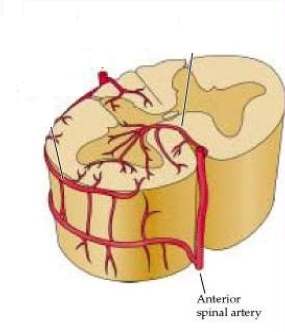

MedFriendly®


Anterior Myelopathy
Anterior myelopathy refers to premature death of tissue in
the anterior (front) spinal artery and/or its branches due to
a decrease or loss of oxygen to this region. An artery is a
blood vessel that carries blood away from the heart. The
anterior spinal artery carries blood to the front 2/3 of the
spinal cord and the medulla. The medulla is a part of the
lower part of the brain that controls certain vital functions
such as breathing, blood pressure, and heart rate.
Because of the damage to the arteries that supply these
regions, their functions are affected to varying degrees
depending on the severity of the damage.
FEATURED BOOK: Clinical Anatomy of the Spine
Anterior myelopathy is considered a type of vascular myelopathy or vascular disease of
the spinal cord. Vascular refers to the blood supply system. There is also posterior
myelopathy, which affects the posterior spinal artery.
WHAT ARE THE SIGNS AND SYMPTOMS OF ANTERIOR MYELOPATHY?
When the anterior spinal cord is damaged, the initial symptom is radiating pain. However,
this eventually changes and there is a loss of pain, decreased temperature sensation,
and weakness or motor paralysis of both arms and legs (known as quadriparesis and
quadriplegia, respectively) at and below the area of spinal cord damage.
"Where Medical Information is Easy to Understand"™

Paralysis is loss of movement and/or sensation. Paraplegia can
also occur, which is loss of the ability to move and/or feel both legs
and generally, the lower trunk (stomach area and lower back). The
paralysis or weakness sets in days after the condition begins. The
limp arms and legs develop spasticity (involuntary muscle
contractions). Reflexes become underactive and later become over-
active.
Since the back part of the spinal cord controls vibration sense and
proprioception, these functions are preserved in patients with
anterior myelopathy. Proprioception is the ability to sense or
perceive the spatial position and movements of the body and the
strength of effort that is needed in movement.
The Babinski sign may be positive in patients with anterior myelopathy, in which the big toe turns upward
when the bottom of foot is stimulated with a blunt instrument. This occurs due to damage to one of the
nerve tracts connecting the brain and the spine.
WHAT CAUSES ANTERIOR MYELOPATHY?
As noted above, anterior myelopathy is caused by a decrease or loss of oxygen to the anterior spinal
artery region. There are numerous causes of this that should be investigated, including a heart attack
(which can cause blood pressure to go too low) and atherosclerosis (narrowing of arteries due to
accumulation of fatty substances). Small blood vessel disease can contribute to the condition as well.
Small blood vessel disease can be caused by an accumulation of glucose due to diabetes mellitus. In
diabetes mellitus, the body is not able to effectively use a natural chemical called insulin, which quickly
absorbs glucose (a type of sugar) from the blood into cells for their energy needs and into the fat and liver
cells for storage. Small blood vessel disease can be caused by neurosyphilis, which is a type of sexually
transmitted disease that spreads to the brain and/or spinal cord. Small blood vessel disease can also be
caused by systemic lupus erythematosis (SLE). SLE is a long-term disease in which the connective
tissues throughout the body are inflamed because the body's defense system attacks these tissues as if
they were foreign substances. Another cause of small blood vessel disease is polyarteritis nodosa, which
is inflammation of small and medium-sized arteries due to being attacked by the some of the body’s own
immune (defense) cells.
Sometimes, the anterior spinal artery can become blocked or compressed, which decreases oxygen flow.
This can be cause by spinal cord tumors outside of the outer protective layer of the spine. It can be
caused by one of the spinal disks breaking off, surgery of the aorta (the largest artery of the body),
aneurysm of the aorta, or dissection (tearing) of the aorta. An aneurysm is a balloon-like expansion of a
blood vessel due to weakening of the blood vessel walls. The reason why an aortic aneurysm can result
in anterior myelopathy is because there are connections that the anterior spinal artery has to the aorta.
Dissection of the anterior spinal artery can also cause anterior myelopathy.
Sometimes, an embolism (travelling blood clot) can cause the decrease or loss of oxygen that causes
anterior myelopathy. This has been known to happen as a complication of diagnostic procedures
evaluating the aorta, such as an aortic angiography (a type of x-ray procedure using special dyes to
produce images). Embolisms can also be caused by decompression sickness, in which gas bubbles form
inside the body after being in areas of high pressure and moving to areas of low pressure.
HOW IS ANTERIOR MYELOPATHY TREATED?
The goal of treatment is aimed at relieving specific signs symptoms such as physical therapy for muscle
spasticity. There is no cure, however.
WHAT IS THE PROGNOSIS FOR THOSE WITH ANTERIOR MYELOPATHY?
Prognosis depends on individual factors such as the cause of the condition, presence of other medical
complications, age, severity of the condition, etc.
WHAT ELSE IS ANTERIOR MYELOPATHY KNOWN AS?
Anterior myelopathy is also known as anterior spinal artery syndrome and Beck’s syndrome.
WHY IS IT CALLED ANTERIOR MYELOPATHY?
Anterior myelopathy comes from the Latin word "ante" meaning "foremost, or front," the Greek word
"myelos" meaning "marrow," and the Greek word "pathos" meaning "suffering." Put the words together and
you get "suffering (of the) front (of the) marrow," where marrow refers to the spine.














